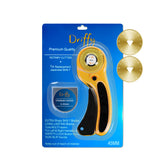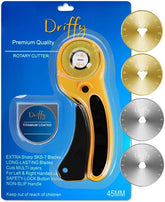Choosing the Right Rotary cutter Blade Material
Choosing the Right Blade Material type
When selecting a rotary cutter blade, it's essential to consider the blade material, as it plays a crucial role in the blade's performance, durability, and longevity. In this section, we'll discuss the advantages and disadvantages of three common blade materials: high carbon steel, steel, and titanium-coated blades.
High Carbon Steel
Advantages:
- High carbon steel blades are known for their exceptional sharpness and ability to maintain a sharp edge for extended periods.
- These blades are often more affordable than other options, making them a popular choice for budget-conscious crafters and quilters.
- High carbon steel is known for its hardness and durability, making these blades suitable for heavy-duty cutting tasks.
Disadvantages:
- High carbon steel blades are more susceptible to rust and corrosion, requiring regular maintenance and proper storage to prevent damage.
- These blades may require more frequent sharpening than other materials, especially when used for cutting abrasive materials like leather or heavy fabrics.
Steel Blades
Advantages
- Steel blades are resistant to rust and corrosion, making them low-maintenance and ideal for humid environments.
- These blades offer a balance between sharpness and durability, suitable for a wide range of cutting tasks.
- Steel is less brittle than high carbon steel, reducing the likelihood of chipping or breaking during use.
Disadvantages
- Steel blades may not hold their edge as long as high carbon steel blades, necessitating more frequent sharpening.
Titanium-Coated Blades
Advantages
- Titanium-coated blades have a layer of titanium applied to the cutting edge, offering increased durability and a longer-lasting sharp edge.
- The titanium coating reduces friction during cutting, resulting in smoother cuts and less strain on the user's hand.
- These blades are resistant to wear, making them ideal for cutting abrasive materials or working on large projects.
Disadvantages
- Titanium-coated blades are typically more expensive than steel or stainless steel blades due to the added manufacturing process.
- While the titanium coating improves durability, the underlying blade material's properties still play a significant role in overall performance.
By understanding the advantages and disadvantages of high carbon steel, stainless steel, and titanium blades, you can make an informed decision when choosing a 45mm rotary cutter blade that best suits your needs and preferences. Keep in mind that factors such as blade maintenance, cutting materials, and budget should also be considered when making your choice.
Maintaining Blade Sharpness
Proper care and maintenance of rotary cutter blades are essential for ensuring their longevity and optimal performance. Here are some tips to help you maintain the sharpness of your blades.
Cleaning
- After each use, carefully wipe the blade clean with a soft, dry cloth to remove any dust, lint, or adhesive residue that may have accumulated during cutting.
- If the blade is dirty or has stubborn residue, use a cotton swab dipped in rubbing alcohol to clean it gently. Avoid using harsh chemicals, as they can damage the blade's surface.
Storage
- Store your rotary cutter with the blade retracted to protect the edge from accidental contact with other objects, which could cause dulling or damage.
- Keep the rotary cutter in a dry, cool place to prevent rust and corrosion. Avoid leaving the cutter in damp or humid environments, as moisture can cause the blade to deteriorate.
- If you have multiple blades, consider using a blade storage container or case to keep them organized and protected from damage.
Sharpening Techniques
- Regularly sharpen your rotary cutter blades to maintain their cutting edge. There are various tools available for this purpose, such as blade sharpeners specifically designed for rotary cutter blades or universal sharpening stones.
- When using a blade sharpener, follow the manufacturer's instructions to ensure the correct sharpening angle and technique.
- As an alternative to commercial sharpeners, you can use a sheet of aluminum foil to help sharpen your blade. Fold the foil multiple times to create a thick layer, then cut through the foil several times with your rotary cutter. This method can help remove burrs and fine-tune the blade's edge.
Blade Replacement
- Even with proper care and maintenance, rotary cutter blades will eventually become dull or damaged. Replace your blade when you notice it requires increased pressure to cut through materials, or when it starts to produce uneven or frayed edges.
- Keep a supply of replacement blades on hand to ensure you always have a sharp blade when needed. Remember to dispose of used blades safely, using a blade disposal container or wrapping them in thick tape before discarding them.
By following these tips on cleaning, storage, and sharpening techniques, you can extend the lifespan of your rotary cutter blades and maintain their sharpness for precise and efficient cutting.












Leave a comment
Please note, comments need to be approved before they are published.